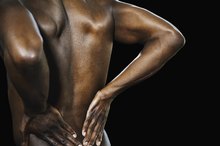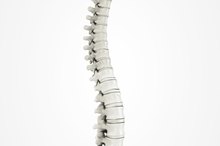C3 and C4 Herniated Disc Symptoms
The bones in the neck region of the spine, known as cervical vertebrae, are numbered 1 to 7 beginning from the top. Discs serve as cushions between the vertebrae. The C3 and C4 disc -- commonly noted as C3-C4 -- is between the third and fourth cervical vertebrae. When a disc tears, or herniates, its gel-like center is pushed outward and can exert pressure on nearby nerves or the spinal cord. Symptoms of a C3-C4 herniated disc may include neck pain, headache, numbness, tingling, weakness and possible loss of bowel or bladder control 3. However, many people with a herniated disc experience no symptoms.
If you are experiencing serious medical symptoms, seek emergency treatment immediately.
Neck Pain
Neck pain caused by a C3-C4 herniated disc can be limited to the neck, just over the disc. In some people, it causes more widespread pain over the cervical spine and into the shoulders and upper chest. It is often worse with neck movement. The pain can be dull and aching, or it might be sharp, burning or cold, depending on the part of the nerve compressed by the bulging disc.
- Neck pain caused by a C3-C4 herniated disc can be limited to the neck, just over the disc.
Headaches
What Are the Causes of Burning Neck Pain?
Learn More
When the C3-C4 disc herniates, the pain sometimes spreads upward to cause a headache 1. The pain is usually at the base of the neck and the lower part of the back of the head. If the headache is severe, it can cause muscle tension with a headache involving most of the head. The headaches often come and go, and may be related to neck movement or position.
- When the C3-C4 disc herniates, the pain sometimes spreads upward to cause a headache 1.
- If the headache is severe, it can cause muscle tension with a headache involving most of the head.
Numbness and Tingling
When a herniated disc at C3-C4 pushes on nerves in the spinal cord, the nerves can send signals of numbness and tingling to the brain. This is a sign that the disc is compressing nerves and could potentially cause permanent damage without treatment. The numbness and tingling are typically felt in the lower neck, upper back and upper shoulder. In some cases, the disc heals by itself and the symptoms disappear.
- When a herniated disc at C3-C4 pushes on nerves in the spinal cord, the nerves can send signals of numbness and tingling to the brain.
- This is a sign that the disc is compressing nerves and could potentially cause permanent damage without treatment.
Weakness and Incontinence
Causes of a Temple Headache
Learn More
Arm and leg weakness can occur if the C3-C4 disc is herniated, because the disc can push on nerves that control movement. If the herniated disc pushes on the part of the spinal cord that controls the function of the bowel or bladder, it is possible to have incontinence -- loss of control over starting and stopping the passage of stool or urine. These symptoms indicate the need to seek prompt medical evaluation to ensure there isn't permanent damage to the spinal cord or nerves.
Herniation of the C3-C4 disc is much less common than herniation of the cervical discs below it. Neck pain associated with a C3-C4 herniation with numbness or tingling requires medical attention but will often improve and resolve with rest, medication and physical therapy. However, neck pain associated with muscle weakness or loss of control of the bowel or bladder requires immediate medical attention. In some cases, surgery may be needed to relieve pressure on the spinal cord.
Reviewed by: Tina M. St. John, M.D.
- Herniation of the C3-C4 disc is much less common than herniation of the cervical discs below it.
Related Articles
References
- The Spine Journal: Isolated C3–C4 Disc Herniations Present as a Painless Myelopathy
- Journal of Neuroscience in Rural Practice: Cervical Disc Herniation Manifesting as a Brown-Sequard Syndrome
- Journal of Medical Case Reports: Cervical Disc Herniation Presenting With Neck Pain and Contralateral Symptoms -- A Case Report
- Family Practice Notebook: Cervical Disc Disease
- Pain Physician: Comprehensive Review of Epidemiology, Scope, and Impact of Spinal Pain
- American Family Physician: Cervical Radiculopathy -- Nonoperative Management of Neck Pain and Radicular Symptoms
- Spine: Spontaneous Regression of Herniated Cervical Disc
- Friedly J, Standaert C, Chan L. Epidemiology of spine care: the back pain dilemma. Phys Med Rehabil Clin N Am. 2010;21(4):659-677. doi:10.1016/j.pmr.2010.08.002
Writer Bio
Julie Graves, MD, PhD, a family doctor and public health expert with more than three decades of experience in medicine, has written for prestigious journals, medical students, and patients alike. An avid scuba diver, hiker and traveler, she helps readers lead healthy and happy lives with sound and sensible advice.









